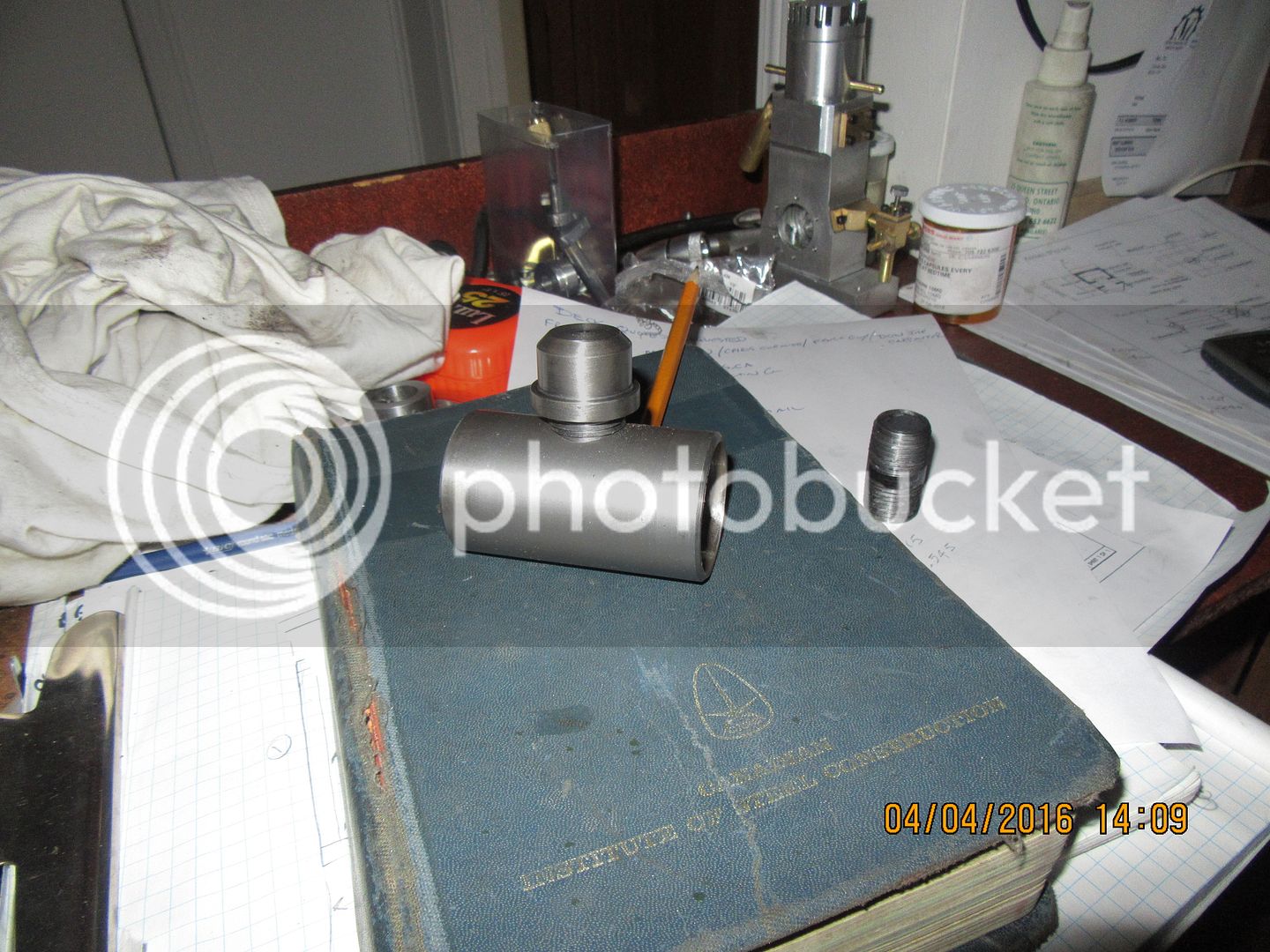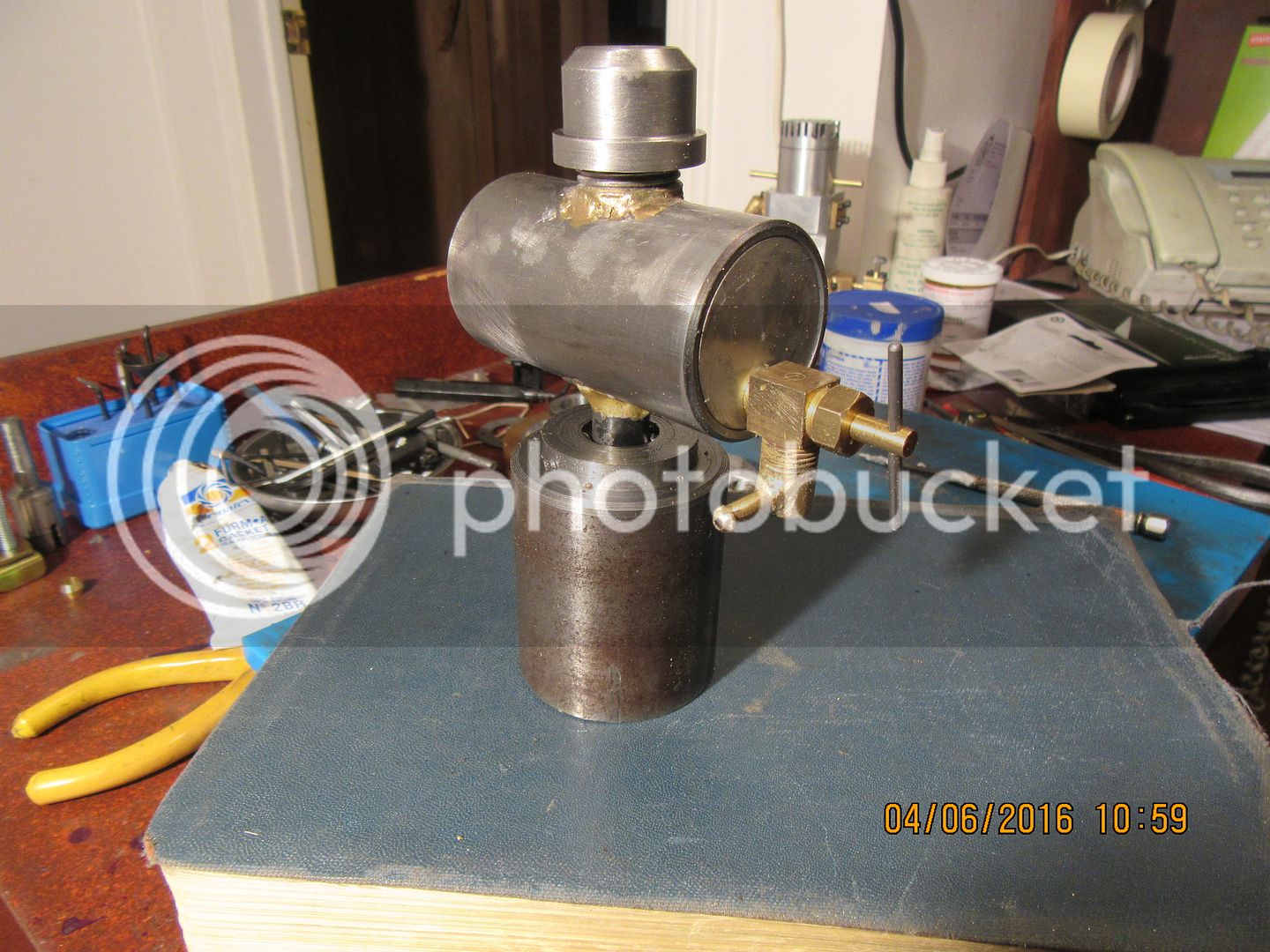You are using an out of date browser. It may not display this or other websites correctly.
You should upgrade or use an alternative browser.
You should upgrade or use an alternative browser.
Old School Barstock 2 Stroke
- Thread starter Brian Rupnow
- Start date

Help Support Home Model Engine Machinist Forum:
This site may earn a commission from merchant affiliate
links, including eBay, Amazon, and others.
Now, with a little creative brazing on the filler neck to body I should have the start on a nice little gas tank. You will see that I have one of the pipe nipples left over. I will throw it in my drawer of "spare stuff". I haven't decided at this point whether to Loctite round discs of 3/8" thick aluminum or possibly brass into the tank to form ends. I have to suss out an adjustable height tank support, and I have to go buy a small shut-off valve and determine just how to attach it. Aluminum is great stuff to machine and work with, but I can't weld or silver solder aluminum, so I have to go carefully now so as not to paint myself into a corner.




I went down to Canadian tire (Canada's generic hardware store) and purchased a shut-off valve that is close to the size I need. It is one that you tie into a cold water line in your plumbing to provide water to your humidifier or refrigerator. I will throw most of these parts away and just use the valve portion. Fortunately for me, I have a 1/8"-27 npt pipe tap which seems to be the correct size. It is part of an old tap and die set that I bought way back when dinosaurs still roamed the earth, and I don't think the pipe taps have ever been used. I have disassembled the valve to ensure that there there isn't a nylon seat or anything in there that the Coleman fuel would dissolve, and there isn't---just a steel needle acting on a brass seat. This will let me make tank ends out of aluminum, which will be "glued" into the ends of the main body with J.B. Weld. I was going to use Loctite, but the J.B. Weld is thicker bodied and will be less apt to leak.



$24.99
$34.99
Bowl Sander Tool Kit w/Dual Bearing Head & Hardwood Handle | 42PC Wood Sander Set | 2" Hook & Loop Sanding Disc Sandpaper Assortment | 1/4" Mandrel Bowl Sander for Woodturning | Wood Lathe Tools
Peachtree Woodworking Supply Inc

$94.99
$109.99
AHS Woodmaster 4400 Maintenance Kit for Outdoor Wood Boiler Treatment
Alternative Heating & Supplies

$39.99
$49.99
Sunnytech Low Temperature Stirling Engine Motor Steam Heat Education Model Toy Kit For mechanical skills (LT001)
stirlingtechonline

$45.99
Sunnytech Mini Hot Air Stirling Engine Motor Model Educational Toy Kits Electricity HA001
stirlingtechonline

$519.19
$699.00
FoxAlien Masuter Pro CNC Router Machine, Upgraded 3-Axis Engraving All-Metal Milling Machine for Wood Acrylic MDF Nylon Carving Cutting
FoxAlien Official
![DreamPlan Home Design and Landscaping Software Free for Windows [PC Download]](https://m.media-amazon.com/images/I/51kvZH2dVLL._SL500_.jpg)
$0.00
DreamPlan Home Design and Landscaping Software Free for Windows [PC Download]
Amazon.com Services LLC

$89.99
Outdoor Wood Boiler Water Treatment Rust Inhibitor- AmTech 300 & Test Kit
Alternative Heating & Supplies

$99.99
AHS Outdoor Wood Boiler Yearly Maintenance Kit with Water Treatment - ProTech 300 & Test Kit
Alternative Heating & Supplies

$39.58
$49.99
Becker CAD 12 3D - professional CAD software for 2D + 3D design and modelling - for 3 PCs - 100% compatible with AutoCAD
momox Shop
This gives a pretty good overview of what the finished tank will look like. I still have to apply the J B Weld to the end caps but I stuck things together long enough to "pose" them for a picture. The 1/2" diameter round stock brazed to the bottom of the tank body will fit into a "receiver" with a set-screw to let me adjust the height of the tank to give the best running characteristics to the engine.


There has been some controversy about how well J B Weld stands up to gasoline or naptha gas. this is a test. Picture #1 shows a batch of J.B. Weld that I mixed up 24 hours ago. It is set up harder than the devil's horn. Picture #2 shows the end cut off the "mixing jar" and submerged in a container of Naptha (Coleman fuel) with a piece of metal setting on it to keep it submerged. I will check it after 24,48, and 120 hours and let you know what happens to it. Does it go soft and sludgy, or stay hard. Time will tell, and I will keep you posted. The container is now covered with a piece of heavy cardboard to keep the Naptha from evaporating.




Regardless of how well the J B Weld stands up to gasoline, here is a little trick worth knowing. Any time you are using epoxy around a part which has a threaded hole in it, plug the hole full of Plasticene (Childrens modeling clay) before-hand. The plasticene will keep the epoxy from running into the threads and making life miserable.


After 24 hours submerged in Naptha gas, (Coleman fuel) the J.B. Weld is completely unaffected. I took the 'sample' out and tried to scratch it with a scriber. I can see no difference in it after 24 hours submersion, so I put it back into the container of gas. I will report again tomorrow on what is happening with it.
canadianhorsepower
Well-Known Member
- Joined
- Oct 22, 2011
- Messages
- 1,671
- Reaction score
- 324
After 24 hours submerged in Naptha gas, (Coleman fuel) the J.B. Weld is completely unaffected. so I put it back into the container of gas.
Hi Brian
it will not be affected eather.
Many years ago I was doing lumberjack event
and I was using JB WELD as build up material
for external transfer ports.
I was using Alcool and Nitro Mix to run
and would flush them with gas and oil mixe
never faille once
Luc--I didn't think it would be, but somebody on another forum said it would go all soft and gooey from gasoline, and I wasn't 100% sure. Better to have a test and make sure than have the end fall out of a full gas tank while test running an engine.---Brian
canadianhorsepower
Well-Known Member
- Joined
- Oct 22, 2011
- Messages
- 1,671
- Reaction score
- 324
Luc--I didn't think it would be, but somebody on another forum said it would go all soft and gooey from gasoline, and I wasn't 100% sure. Better to have a test and make sure than have the end fall out of a full gas tank while test running an engine.---Brian
Brian
Totally agree with you
better be safe then sorry
but some peoples only read 1/2 of the
instruction :wall::wall:
cheers
Sometimes you just have to put everything together and see what it all looks like assembled. I'm pretty pleased with this. My o-ring drive-belt is actually thicker than the one which will ultimately be used, but it was the right length for a mock-up. The gas line running from the gas tank to the carburetor is pretty well horizontal. The tank sets higher than the carb jet, so it needs the shut off valve I have mounted on the tank. The large vertical tube is a water coolant reservoir. Water runs from the bottom of it over to the gear pump. The gear pump pumps water out the top, thru the tube to the engine cooling passage around the cylinder, out the other side of the engine, and then back thru that overhead tube and is discharged back into the top of the cooling reservoir. I will make something a bit more "pleasing to the eye" than that long tube which returns water to the coolant reservoir from the engine. I'm still waiting for my Loctite 574 so I can re-assemble the engine and see if it will run.


The gas tank has been leak-tested by filling it with Naptha and letting it set 15 minutes with the valve closed. Nothing leaked. My Loctite 574 has just arrived, and it smells pretty benign but is covered with all kinds of dire warnings about skin reactions, etcetera. It is the same color as orange soda pop and perhaps a bit thicker than Loctite 638 which I use all the time. I may go up to the drugstore and buy a pair of light rubber gloves to wear when applying it. I'd like to get the liner installed tonight so it can set up overnight before I start to reassemble the engine. While I was out picking up the loctite, I stopped at the auto parts store and picked up a 3/16" o.d. metal brakeline to replace that big loop of cooling hose that sticks up above the engine.
Well, for better or worse, the liner is Loctited in place. I decided to risk a finger and save a trip to the drugstore to get rubber gloves. I had a good wash with lots of soap and hot water after the deed was done and my finger doesn't seem any worse for the experience. Now if the Loctite just sets up properly overnight, and the water jacket is sealed so it don't leak cooling water into the crankcase I MAY soon have a runner!!!
We've got a lot of snapping and popping going on!!! Engine has good compression, and is trying hard to run. It almost runs in either direction!! I'm having a hard time finding that "sweet spot" where the engine takes hold and begins to rev up faster than the drill is turning it. My waterpump is leaking somewhere, and I will have to address that sooner or later, but I want the engine running first.
Enough for today. I still don't have a runner. Lots of compression, lots of firing, but no real runs. I must say, I'm not too impressed with this business of having the gas tank higher than the carburetor. All the time that I'm trying to start the engine, there is fuel dripping out the intake side of the carb, and yet the engine is acting like it's starving for fuel. I'm afraid of the fire hazard. I took off the belt that was driving the waterpump, thinking perhaps it was putting too much load on the engine (it shouldn't) but it made no difference. I have tried many different ignition timing settings and found where it seems to work best as indicated by engine firing. This is a quandary!! If the engine was a four stroke, it would have ran by now. I don't even have any leaking valves to blame. The only thing I can think of at the moment that I have left to mess with is the height of the gas tank in relationship to the carburetor. Maybe tomorrow I'll lower the tank and see what happens.
Brian, what is your fuel mix? (Just curious, I don't have anything to suggest.)
Similar threads
- Replies
- 14
- Views
- 8K













































